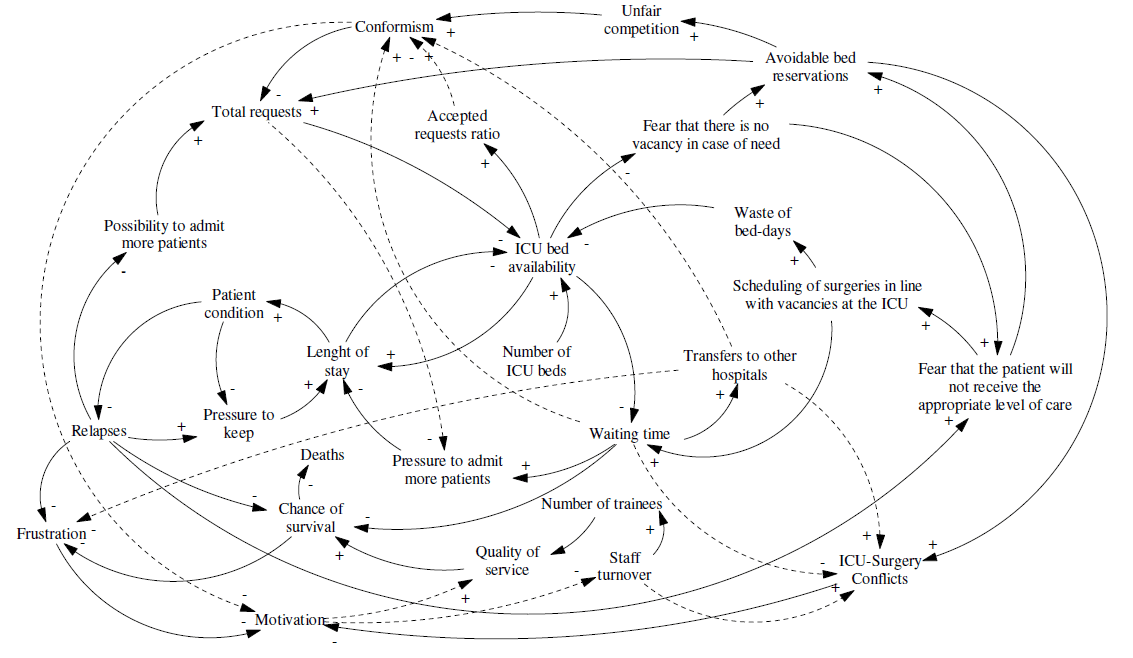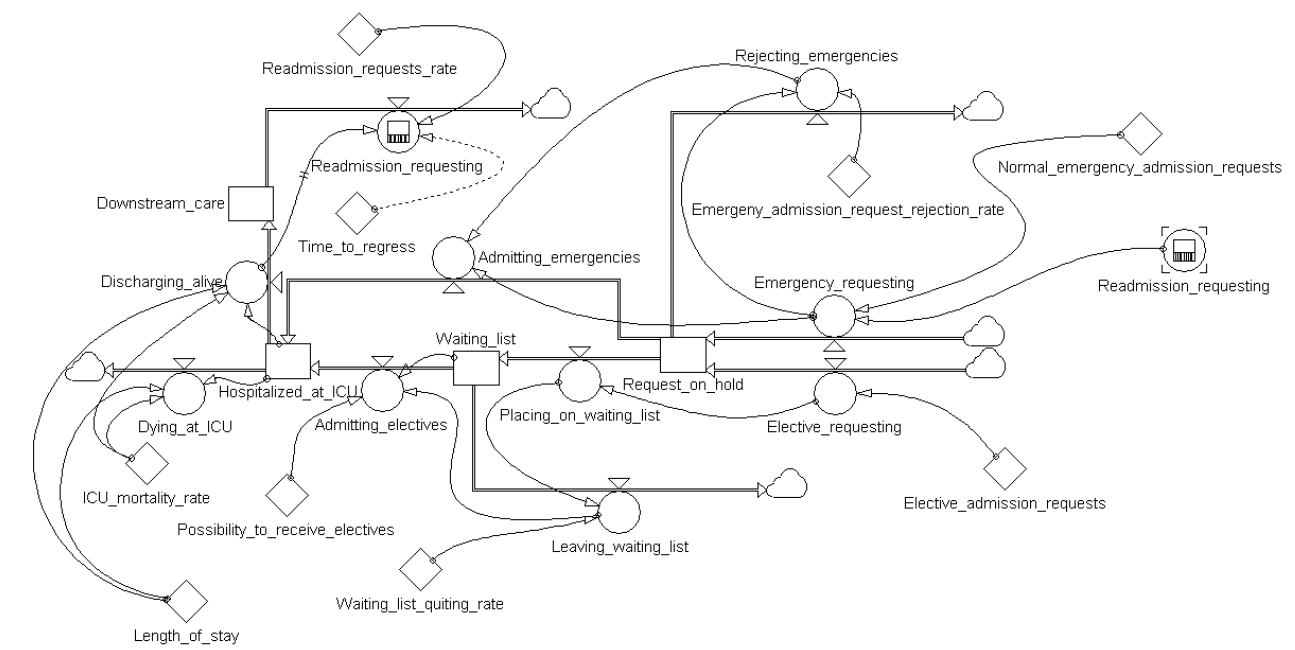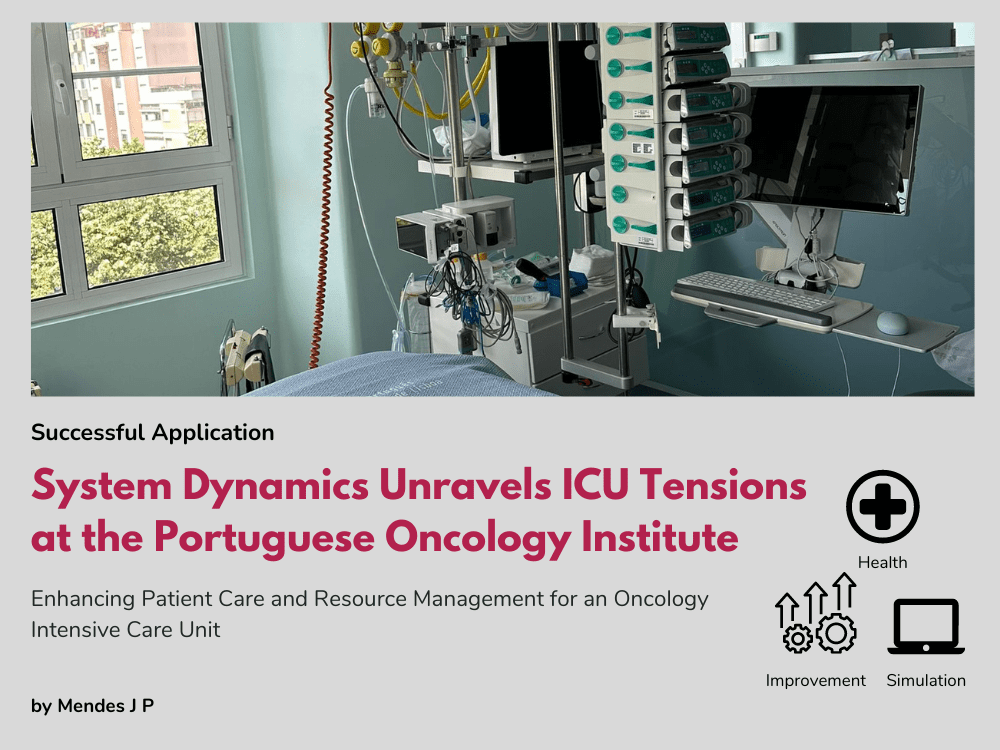System Dynamics Unravels ICU Tensions at the Portuguese Oncology Institute
EXECUTIVE Summary
-
The Portuguese Oncology Institute (IPO) faced a critical challenge in its intensive care unit (ICU) where doctors and nurses experienced high turnover due to tensions with surgeons and limited resources, ultimately leading to a high death rate. Surgeons accused ICU staff of holding patients longer than necessary, leading to a backlog in surgeries. Despite utilizing external ICUs, the issue persisted.
-
Multicriteria and optimization approaches did not provide a solution. Only a System Dynamics approach using a management flight simulator enabled IPO’s leadership to understand the dynamics and discuss the causes and leverage points around the problem.
-
Based on the System Dynamics model, the IPO established 10 new beds in the appropriate care units leading to the resolution of tensions and decreased turnover and death rates in the ICU.
#IPO #PatientCare #Oncology #Health #Portugal
The Problem
Despite the demanding nature of the work in IPO’s intensive care unit (ICU), doctors and nurses were passionate about their roles. However, the turnover rate was high due to strained relationships with their colleagues. Surgeons, who would only schedule delicate surgeries when the ICU had availability, accused the ICU staff of unnecessarily prolonging patient stays and not vacating beds promptly. As a result, the ICU became a bottleneck, leading to a growing waiting list for surgeries. To address the issue, management began utilizing external ICUs, but this did not alleviate the resentment or reduce turnover. Figure 1 displays the growth of the quitting rate of the IPO’s ICU waiting list, which is the rate at which patients leave the waiting list without being admitted to the ICU for surgery.
Figure 1 – Cumulative distribution of waiting list quitting rate

The ICU faced a high death rate, and care sharply declined when patients left for general wards, as readmission was rare due to bed shortages. To prevent readmission or premature deaths, the ICU kept patients until they were stable for general wards. Surgeons hesitated to operate on fragile cancer patients without available ICU beds. Despite being undersized, the ICU’s high cost per bed (equipment and staff) deterred expansion. IPO’s management hesitated to invest in ICU or intermediate care, as adjacent wards needed more beds for patients awaiting surgery. This compromised the organization’s performance.
The Solution
By employing the System Dynamics approach, stakeholders in the IPO’s ICU, including doctors, nurses, surgeons, and management, were able to gain valuable insights into the intricate interactions and dilemmas that existed. The approach provided a platform to examine the underlying causes of the tensions, identify the systemic drivers contributing to high turnover, and uncover the unintended consequences of certain actions. Figure 2 shows the causal loop diagram (CLD) that was developed along with the medical team and used to discuss the uses of a management flight simulator.
Figure 2 – CLD used for discussion with medical team

Through the use of the management flight simulator, stakeholders were able to witness the unfolding dynamics of the problem. This new understanding enabled IPO’s leadership to make informed decisions and take proactive steps to address the challenges. Figure 3 shows the core components of the System Dynamics model underlying the management flight simulator.
Figure 3 – Simulator core, showing the waiting list at the bottom

Outcomes
The application of the model had a significant impact on IPO’s management. As a result, a new Intensive and Intermediate Care Unit was established, reducing reliance on external ICUs and improving resource management. The ICU’s limited capacity and absence of intermediate care beds had previously led to high death rates and compromised patient care during the transition to general wards. Additionally, the practice of retaining patients in the ICU until they were fit for general wards caused delays in surgeries and increased costs.
With the opening of the new unit, equipped with 6 intensive care beds, 4 intermediate care beds, and 2 isolation rooms, these issues were effectively addressed. IPO’’s dependence on external ICUs was significantly reduced, leading to improved resource allocation within the organization. The expanded capacity and inclusion of intermediate care beds ensured smoother patient transitions and better continuity of care. Timely scheduling of surgeries enhanced efficiency and reduced costs while curbing death rates. The establishment of the Intensive and Intermediate Care Unit demonstrated IPO’s commitment to improving patient outcomes, resulting in a positive impact on both patient care and organizational performance.
OTHER SUCCESSFUL APPLICATIONS
Solving Bottlenecks in Dairy Production Facilities with System Dynamics
Solving Bottlenecks in Dairy Production Facilities with System Dynamics EXECUTIVE Summary FrieslandCampina faced potential bottlenecks in production due to the merging of two factories. They hired SD&Co which employed system dynamics simulation models to predict...
A Design Value Calculator: A System Dynamics Boardgame
A Design Value Calculator: A System Dynamics Boardgame EXECUTIVE Summary Product design is a specific form of complex innovation that touches all areas of an organization’s management. While entrepreneurs recognise the value of design, they often tend to focus...
The World Bank Uses System Dynamics to Identify Root Causes of Poverty
The World Bank Uses System Dynamics to Identify Root Causes of Poverty EXECUTIVE Summary Madagascar has one of the highest poverty rates in the world. In 2022, an astonishingly three out of every four people in Madagascar lived below the poverty line. Poverty has...
Upcoming Events
Health Policy SIG Networking and Collaboration Event
Please join us for our quarterly Health Policy SIG virtual social hour! Agenda: TBD
Recent Posts
Society Governance Updates
Society Governance Updates Welcome, Allyson! New President Allyson Beall King joined the Policy Council as our 2024 President. Her primary role is as director of the Washington State University School of the Environment, which focuses on regional ecologies and our...
Call for Presenters: Seminar Series
Call for Presenters: Seminar Series We at the System Dynamics Society are continually seeking vibrant and knowledgeable presenters for our ongoing Seminar Series. As we unfold the calendar, there’s always a place for more insights, experiences, and expertise to enrich...
Honoring Excellence: A Glimpse into the Awards of the International System Dynamics Conference
Honoring Excellence: A Glimpse into the Awards of the International System Dynamics Conference The International System Dynamics Conference brings together experts, practitioners, and students to exchange ideas, showcase real-world applications, and celebrate...
Join us
OTHER SUCCESSFUL APPLICATIONS
Solving Bottlenecks in Dairy Production Facilities with System Dynamics
Solving Bottlenecks in Dairy Production Facilities with System Dynamics EXECUTIVE Summary FrieslandCampina faced potential bottlenecks in production due to the merging of two factories. They hired SD&Co which employed system dynamics simulation models to predict...
A Design Value Calculator: A System Dynamics Boardgame
A Design Value Calculator: A System Dynamics Boardgame EXECUTIVE Summary Product design is a specific form of complex innovation that touches all areas of an organization’s management. While entrepreneurs recognise the value of design, they often tend to focus...
The World Bank Uses System Dynamics to Identify Root Causes of Poverty
The World Bank Uses System Dynamics to Identify Root Causes of Poverty EXECUTIVE Summary Madagascar has one of the highest poverty rates in the world. In 2022, an astonishingly three out of every four people in Madagascar lived below the poverty line. Poverty has...
Recent Posts
Society Governance Updates
Society Governance Updates Welcome, Allyson! New President Allyson Beall King joined the Policy Council as our 2024 President. Her primary role is as director of the Washington State University School of the Environment, which focuses on regional ecologies and our...
Call for Presenters: Seminar Series
Call for Presenters: Seminar Series We at the System Dynamics Society are continually seeking vibrant and knowledgeable presenters for our ongoing Seminar Series. As we unfold the calendar, there’s always a place for more insights, experiences, and expertise to enrich...
Honoring Excellence: A Glimpse into the Awards of the International System Dynamics Conference
Honoring Excellence: A Glimpse into the Awards of the International System Dynamics Conference The International System Dynamics Conference brings together experts, practitioners, and students to exchange ideas, showcase real-world applications, and celebrate...
Upcoming Events
Health Policy SIG Networking and Collaboration Event
Please join us for our quarterly Health Policy SIG virtual social hour! Agenda: TBD


